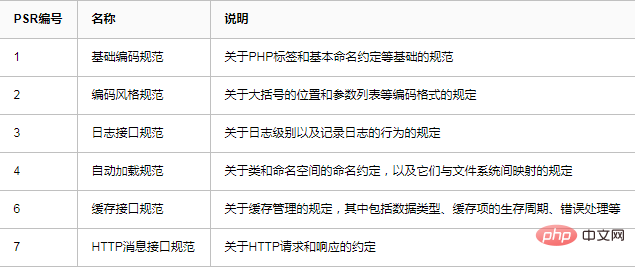

Due to the flexibility of PHP, many people do not pay attention to a good code specification when writing code, making the already flexible PHP code look messy. In fact, the PSR specification PSR-1 and PSR-2 have defined some specifications in PHP coding. As long as we follow these specifications well, we can write very beautiful and neat code even when using a flexible scripting language. First, let’s take a look at the passed PSR specifications, and then briefly explain some of the specific requirements of the PSR-1 and PSR-2 specifications.
Passed PSR

##PSR-1 Basic Coding Specification
( 1) Opening and closing tags First of all, the PHP code must start with the (2) Side effects PHP files either declare classes, interfaces, functions, etc., or perform logical operations (such as reading and writing files or sending output to the browser), but they should not do both at the same time Both. (3) Naming The naming of the class must comply with the camel case naming convention starting with an uppercase letter. In other words, class names should start with a capital letter. There is no requirement to name properties, but they should be consistent. Method names must conform to the camelCase naming convention starting with lowercase. All letters in class constants must be capitalized, and words are separated by underscores. Related recommendations: "PHP Knowledge"
PSR-2 Coding Style Specification
(1) PSR -1 requires PHP code to start with tag, but should end with a blank line. (2) A blank line should be inserted after the namespace declaration, and there should also be a blank line after the use statement block. Don't make multiple use statements in the same line of code. (3) The beginning and end of the class class keyword, class name, and extends and implements keywords must be on the same line. If a class implements multiple interfaces, the interface names can be on the same line of the class declaration, or they can occupy separate lines. If you choose to place these interface names on multiple lines, the first interface name must be on its own line and not follow the implements keyword. The opening brace ({) of a class should be written on its own line after the function declaration, and the closing brace (}) should also be written on its own line after the class body. That is, the class declaration looks like thisclass EarthGame extends Game implements Playable, Savable { //类体 }
class EarthGame extends Game implements Playble, Savable { //类体 }
·Single-line declaration
The opening curly brace ({) of the method should be written on its own line after the method name, and the closing curly brace (}) should also be written on the method The body should be on its own line (directly following the method code). Method parameter lists should not start or end with spaces (i.e. they should follow the parentheses surrounding them). For each parameter, there should be a comma after the parameter name (or default value), and a space after the comma. This may sound complicated, as follows:final public static function generateTile(int $diamondCount, bool $polluted = false) { //方法体 }
·Multi-line declaration
A single-line method declaration is not practical if the method has many parameters. At this point we can split the parameter list so that each parameter (including type, parameter variable, default value, and comma) is on its own indented line. In this case, the closing parenthesis should be placed on the line after the parameter list, aligned with the beginning of the method declaration. The opening curly brace ({) should follow the closing parenthesis on the same line, separated by a space. The method body should start on a new line. Again, this may sound complicated, but the following example should help you understand this rule.public function __construct( int $size, string $name, bool $warparound = false, bool $aliens = false ) { //方法体 }
$earthGanme = new EarthGame( 5, 'earth', true, true ); $earthGame::generateTile(5, true);
流程控制关键字(if、for、while等)后面必须紧跟一个空格。但是,开始圆括号后不能有空格。同样,结束圆括号前不能有空格。因此内容应该紧贴在括号内的。与类和(单行)函数声明相比,流程控制代码的开始花括号应该与结束圆括号在同一行。结束花括号应该自成一行。以下是一个简单的示例。
$title = []; for ($x = 0; $x < $diamondCount; $x++) { if ($polluted) { $title[] = new PollutionDecorator(new DiamondDecorator(new Plains())); } else { $title[] = new DiamondDecorator(new Plains()); } }
注意if和for之后的空格。for和if语句与圆括号在同一行,而且它们的结束圆括号后都有一个空格,然后是流程控制体的开始花括号。
The above is the detailed content of Basic specifications of PHP coding style. For more information, please follow other related articles on the PHP Chinese website!